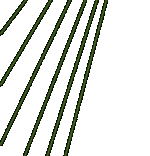Holographic
interferometry
Interferometry of phase objects
The real objects, that
are used in experiments, change both phase and amplitude and direction of propagation of
radiation. It results that the basic criterion of applicability of each method is the size
of an error which is brought by them to final result.
It is considered to
count, that it is allowed to use interferometric methods of diagnostics for transparent
objects, if maximal refraction on an object does not exceed 0.1 mrad, and the influence of
absorption can be neglected. Such transparent objects also have received the name phase,
that are varying only phase of sounding radiation.
It is always necessary
to remember, as classical and holographic interferometry give correct results only for
phase objects.
Types of interferometer
adjustment
Shape and the ways of
decoding interferometric pattern, that is given by any interferogram (holographic or
classical) depend on adjustment of interferometer.
1) Infinitely wide
strip
If after registration
of the first basic hologram, neither object nor reference beam are not changed, all
changes in resulting interference pattern will be caused only by phase shift in each point
of wave front, caused by the processes which have occurred in object between exposures (in
a method of two expositions) or during shooting (in a method of real time).
In this case we can
say, that interferometer is adjusted on an infinitely wide strip.
This term has appeared
because of fact, that at interference of identical wave fronts propagating in the same
directions and having constant phase shift in all points, resulting interference pattern
represents a unique strip — dark or light, depending on a relation of phases of
interfering waves.
At such way of
adjustment, changes in object between exposures will be shown in occurrence of closed
strips, which contour heterogeneity, and take place inside it. However, it is possible to
decode such interference pattern, only with known sign of change of the phase shift at
transition from one strip to another. In a received picture this information is
absent.
2) Strips of finite
width
If an object or
reference beam or photoplate has turned on some angle during the interval between
exposures, resulting interference pattern will be observed on a background of regular
system of parallel strips. The step of these strips is defined by the size of an angle of
turn, and the orientation of strips depends on methods of their creation.
Such interferometer
adjustment has named as adjustment of strips of finite width.
In this case,
heterogeneity in the object is shown as a curvature of basic system of strips.
Preliminary information
is not necessary for decoding such interference pattern. The sign of change phase shift,
or direction of the strips counting, is set by a direction of shift of optical elements of
the scheme at creation of system of these strips.
Preparation and treatment of
silver-halide emulsion at holographic interferometry
It is a half of problem
to write down and to restore holographic interferogram. It is required to decode the
received picture. To obtain correct results from decoding, it is necessary to take into
account a number of features, which extremely influence a reliability of the information,
received with holographic interforogram.
The technology of
information production, using the holographic interferograms, is very sensitive to slight
emulsion shrinkage, that distort recorded interference pattern and, as result, its
incorrect decoding. Therefore it is necessary to accept special measures to complete
shrinkage elimination, or to achieve its minimum.-->
|





